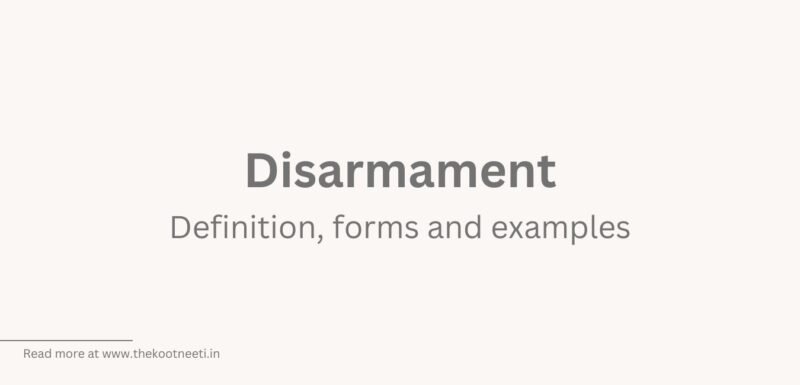Disarmament: Definition, forms and examples

Disarmament refers to the reduction or elimination of military forces and weapons, either unilaterally or through international agreements. Disarmament can be motivated by a variety of factors, including the desire to reduce the risk of conflict, to reduce military expenditure, or to address concerns about the proliferation of weapons of mass destruction.
There are a number of different forms of disarmament, including:
- Nuclear disarmament: This refers to the reduction or elimination of nuclear weapons, either through bilateral or multilateral agreements.
- Conventional disarmament: This refers to the reduction or elimination of conventional military forces and weapons, such as tanks, aircraft, and missiles.
- Chemical disarmament: This refers to the reduction or elimination of chemical weapons, such as nerve agents and mustard gas.
- Biological disarmament: This refers to the reduction or elimination of biological weapons, such as pathogens that can be used as agents of warfare.
Disarmament can be a complex and challenging process, and it requires the cooperation of multiple states and other actors. It is often carried out through international agreements and organizations, such as the United Nations and the Organization for the Prohibition of Chemical Weapons.
There have been a number of significant examples of disarmament throughout history, including:
- Treaty of Trianon: This treaty, which was signed in 1920 following World War I, resulted in the disarmament of Hungary and the reduction of its military to 35,000 personnel.
- Washington Naval Treaty: This treaty, which was signed in 1922, resulted in the disarmament of the United States, the United Kingdom, Japan, France, and Italy, and set limits on the size of their navies.
- Strategic Arms Reduction Treaty (START): This treaty, which was signed in 1991, resulted in the reduction of the number of strategic nuclear weapons held by the United States and the Soviet Union.
- Chemical Weapons Convention (CWC): This convention, which was signed in 1993, resulted in the destruction of many of the world’s chemical weapons stockpiles and established a system for monitoring and verifying the destruction of remaining stockpiles.
- Intermediate-Range Nuclear Forces Treaty (INF): This treaty, which was signed in 1987, resulted in the elimination of a class of nuclear missiles with a range of 500-5,500 kilometers.
Overall, these examples demonstrate the challenges and potential benefits of disarmament, and illustrate the role that international agreements and organizations can play in promoting disarmament and nonproliferation.
Disarmament conference 1932
The disarmament conference of 1932 was an international conference held in Geneva, Switzerland, with the aim of reducing the level of armaments around the world. The conference was held in the aftermath of World War I, which had seen a dramatic increase in military spending and armaments production.
The conference was attended by representatives from a number of countries, including the United States, the United Kingdom, France, and Germany. The conference resulted in the adoption of the World Disarmament Conference Plan, which called for the reduction of armaments and military budgets, the establishment of an international commission to oversee disarmament, and the creation of a World Court to settle international disputes.
However, the disarmament conference ultimately failed to achieve its goals. The onset of the Great Depression and the rise of authoritarian regimes in Europe led to an increase in military spending and a decline in international cooperation. The conference ultimately ended without any significant progress towards disarmament.


















